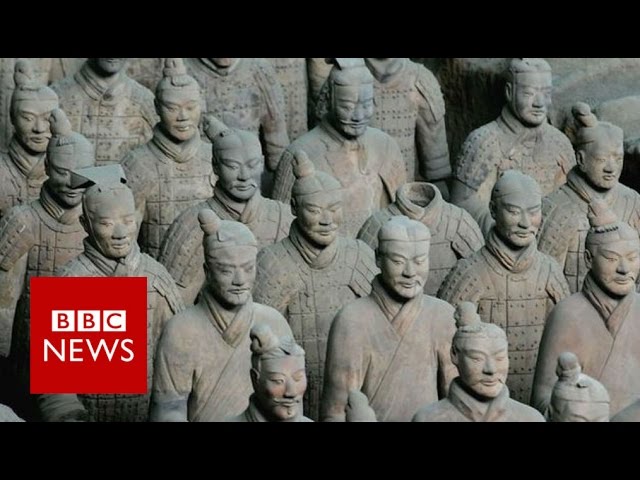The Terracotta Warriors are a collection of terracotta sculptures depicting the armies of Qin Shi Huang, the first Emperor of China. The figures, dating from 210–209 BCE, were discovered in 1974 by some local farmers near Xi’an, Shaanxi province, China. The figures vary in height according to their roles, with the tallest being the generals. The figures include warriors, chariots, horses, officials, acrobats, strongmen, and musicians. Current estimates are that in the three pits containing the Terracotta Army there were over 8,000 soldiers, 130 chariots with 520 horses, and 150 cavalry horses, the majority of which are still buried in the pits.
Origin and History
The Terracotta Army was commissioned by Qin Shi Huang, the first Emperor of China, to serve as an afterlife guard for him in the afterlife. He began the project in 246 BCE, soon after he ascended the throne at the age of 13, and it took almost 40 years to complete. The figures were created with the help of government workers and skilled craftsmen using local materials. The faces of the figures were based on real people from the area. The figures were then placed in three pits near the emperor’s mausoleum, which was located near present-day Xi’an, Shaanxi province.
Discovery
The Terracotta Army was discovered by accident in 1974 by some local farmers digging a water well near the emperor’s mausoleum. Archaeologists soon began excavating the site, and they uncovered thousands of life-size terracotta figures. The figures were originally painted with bright colors, but these had faded over time. The figures have since been restored and are now on display in the nearby museum.
Significance
The discovery of the Terracotta Army is one of the most important archaeological finds of the 20th century. It provides an insight into the culture and beliefs of the ancient Chinese, and has been described as a “must-see” for anyone interested in Chinese history. The figures also provide evidence of the level of craftsmanship achieved by the Chinese during this period. The figures are also a testament to the power and wealth of the Qin dynasty, which unified China for the first time in history.
Features of the Terracotta Warriors
The figures vary in height according to their roles, with the tallest being the generals. The figures include warriors, chariots, horses, officials, acrobats, strongmen, and musicians. Some of the figures are also equipped with weapons, including swords, spears, and crossbows. Each figure has unique facial features, hairstyles, and clothing, and they were all painted with bright colors. The figures are also intricately detailed, and some of the horses are even saddled with bridles.
The Three Pits
The figures were placed in three pits near the emperor’s mausoleum. Pit 1 is the largest and contains the main army, while Pit 2 contains the officers and Pit 3 contains the cavalry. The pits are arranged in a precise formation, with the main army facing east, the officers facing west, and the cavalry facing south. The pits are also divided into corridors, with each corridor containing a specific type of soldier.
Preservation
The figures have been carefully preserved since their discovery in 1974. They have been restored, and some of them have been moved to museums for display. In addition, the site of the Terracotta Army is now a UNESCO World Heritage Site. The site is open to visitors, and there are guided tours available to learn more about the history and significance of the figures.
Conclusion
The Terracotta Army is an incredible archaeological discovery, providing an insight into the culture and beliefs of the ancient Chinese. The figures are a testament to the power and wealth of the Qin dynasty, and they provide evidence of the high level of craftsmanship achieved by the Chinese during this period. The figures have been carefully preserved and are now open to visitors, allowing them to learn more about the history and significance of this remarkable find.


